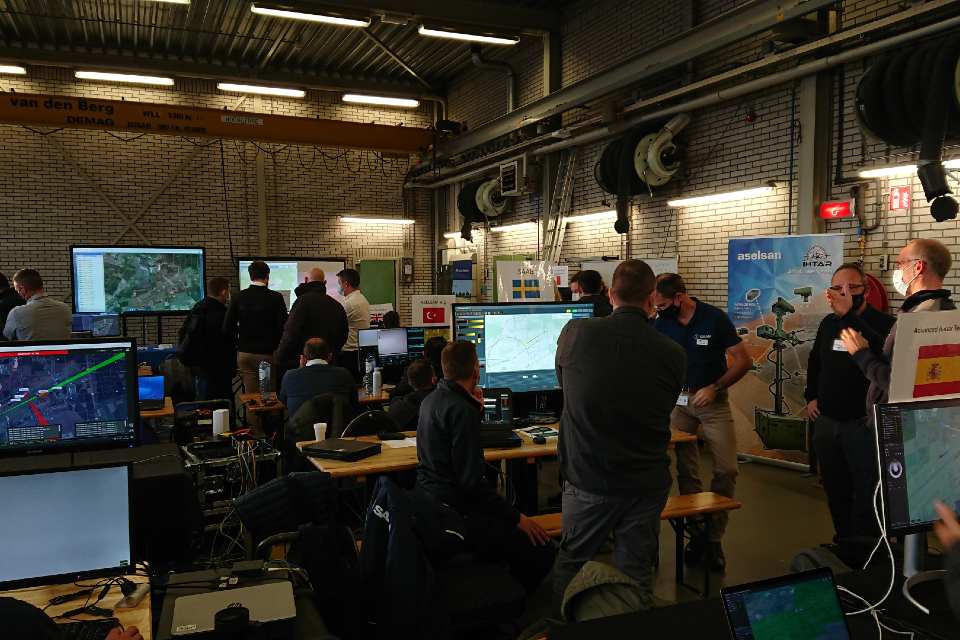SAPIENT autonomous sensor system
Development of a standard approach for AI and autonomy in networked multi-sensor systems in security and defence.
Sensing for Asset Protection with Integrated Electronic Networked Technology (SAPIENT) uses autonomy to reduce the workload of people operating multi-sensor systems, in security and defence scenarios.
It is the concept of a network of advanced sensors with artificial intelligence (AI) at the edge, combined with intelligent fusion and sensor management.
The benefits of SAPIENT include:
- significantly lower cognitive burden on operators
- lower communications bandwidth
- operational flexibility
- dual defence and security use
- lower acquisition cost
SAPIENT has been adopted by MOD as the standard for counter-UAS (uncrewed air system) technology. It is also being evaluated as a potential NATO standard for counter-drone systems.
Use the SAPIENT standard
The SAPIENT architecture is owned by MOD, but the interface control document (ICD) is freely available as British Standards Institute (BSI) Flex 335, to encourage suppliers and partners to adopt the standard, contribute towards its development, and exploit the technologies created under this initiative.
- Access BSI Flex 335
- Download proto files and other implementation tools and documentation from GitHub
SAPIENT Test Harness and SAPIENT Middleware software
The SAPIENT Test Harness is a software tool that would typically be used during development and testing of a SAPIENT component to evaluate compliance of messages produced by the component with the SAPIENT standard – BSI Flex 335 v2.
The SAPIENT Middleware is a non-mandatory component in the SAPIENT architecture. It would typically be used in an operational SAPIENT system to route messages between SAPIENT nodes and to log the messages produced by the nodes to a database. A basic Application Programming Interface (API) can be used by external systems to access SAPIENT data stored by the middleware.

Limitations of current systems
Most security and situational awareness systems, such as CCTV cameras or drone detection systems, simply collect data from their sensors and feed it ‘raw’ to an operator who assesses the situation and directs the system accordingly. Monitoring and interpreting lots of data requires high communications bandwidth and places a high cognitive burden on the operator.
How SAPIENT works
In the SAPIENT system, the individual sensors are advanced, using artificial intelligence (AI) to make detections and classifications locally, sending only the information not the raw data, to the command and control system. They also make operating decisions autonomously, such as which direction to look or whether to zoom in, in order to fulfil higher-level objectives. These higher-level objectives are managed by a decision-making module which controls the overall system and makes some of the decisions normally made by the operators. This reduces the operator’s need to constantly monitor the output of the sensors.
Encouraging system integration and development of compatible modules
SAPIENT is a MOD-owned, open-architecture that specifies the standards and protocols that allow modern AI algorithms to work in concert across a suite of sensors. These algorithms reside both on-board the sensor nodes - embodying AI at the edge - and at decision-making nodes. The architecture strongly encourages component modularity (the ability to plug-and-play these modules) which reduces system integration time and creates a competitive supplier ecosystem for the components.
Critically, SAPIENT is designed to enable multi-sensor fusion (correlation, association and tracking) and sensor management (dynamic tasking of the sensors in response to the unfolding scenario). This gives MOD access to the advanced AI solutions that are being developed by our innovative supplier base.
While the key outputs from the SAPIENT initiative are the standards (that is: the ICD) to enable innovative suppliers to develop sensor and decision-making node components, the SAPIENT project has also developed research versions of these components to demonstrate the concept and evaluate the benefits to users.
SAPIENT in action
SAPIENT has been used in a number of high profile international exercises and experiments, leading to wider adoption by industry and partners.
In November 2021 SAPIENT’s ICD was evaluated as an interoperability standard for multi-sensor counter-UAS systems, at the NATO technical interoperability exercise (TIE21) in The Netherlands. It was highly successful in facilitating over 70 connections between C-UAS sensor systems and Command and Control (C2) systems. It was further evaluated at TIE22 in September 2022, where it enabled 31 advanced autonomous sensor nodes from different vendors to connect to 13 decision-making nodes.

In September and October 2021 SAPIENT standards, decision-making nodes and compatible sensors were used in the Contested Urban Environment 2021 (CUE2021) exercise. This multinational experiment involved over 60 innovative technologies, many of which were developed as SAPIENT compliant and shared their data using the SAPIENT ICD. Multi-sensor fusion and sensor management was provided by the advanced AI in the SAPIENT decision-making node. This illustrated SAPIENT’s critical place in a scalable, layered intelligence, surveillance and reconnaissance (ISR) capability of the future, delivering enhanced situational awareness to support command and control of operations in complex terrain and more efficient employment of ISR assets.
CUE2021 followed on directly after a NATO Science and Technology Organization trial investigating architectures for Interoperability and Networking of Disparate Sensors and Platforms for ISR Applications. Here SAPIENT was deployed, in concert with other architectures (Open Standards for Unattended Sensors and the OGC’s Sensor Web Enablement), as an integrating infrastructure for multinational mobile and fixed ISR assets.

Future development
SAPIENT started as a jointly funded project by the Defence Science and Technology Laboratory (Dstl) and Innovate UK. Dstl is now working with multiple stakeholders in defence and across government to consider the applicability of the SAPIENT concept, standards and architecture for military and civilian security applications, whilst working with industry partners to exploit the technologies created under this initiative.
SAPIENT has most recently been published by the British Standards Institute (BSI) as BSI Flex 335.
The UK MOD has already adopted SAPIENT as a standard for counter-drone technology, specified in the 2019 Counter-Unmanned Air Systems (C-sUAS) Strategy.
The Rapid Innovation Cell (RIC), part of the UAS Capability Development Centre (UASCDC), holds a regular programme of test and evaluation events to establish the efficacy of commercially available capabilities and verifies SAPIENT compatibility for all C-sUAS equipment put forward for testing.
Beginning with version 7 of the SAPIENT ICD, SAPIENT has moved from a XML-based message format to a binary Protobuf-based message format. This reduces the communications bandwidth required to run SAPIENT by approximately 60%. Although previous XML instantiations of SAPIENT were not high-bandwidth, the transition to Protobuf will better support the adoption of SAPIENT in challenging tactical military operations where communications bandwidth is very limited.
Future development of SAPIENT will investigate how multiple SAPIENT systems can be connected together in a hierarchy. Creating hierarchies of SAPIENT systems will improve the scalability and robustness of SAPIENT, and expand the range of real-life scenarios where SAPIENT could be credibly deployed.
SAPIENT Standardisation Committee (S3C)
To support SAPIENT as it matures towards a deployable capability meeting the needs of various stakeholders, Dstl has a cross-industry, cross-stakeholder working group, known as the SAPIENT Standardisation Committee. The S3C aims to create a configuration control framework around the SAPIENT interface and tools.
Membership of the committee is open to all but operates on a non-funded, voluntary basis. If you would like to be involved in the S3C, please contact us.
Contact us
Email SAPIENT@dstl.gov.uk
You can also find out more about Dstl’s sensing science and technology capability.
Updates to this page
-
We have recently released a SAPIENT Test Harness and SAPIENT Middleware software as open-source software on GitHub.
-
Updated link to version 2 of BSI Flex 335 and changed the name of the cross-industry, cross-stakeholder working group to the SAPIENT Standardisation Committee (S3C).
-
Updated link to SAPIENT ICD – the latest version is on the British Standards Institute website as BSI Flex 335; details of the differences are available on the Dstl GitHub.
-
Updated information about version 7 of the interface control document and future development of SAPIENT.
-
Added link to the middleware and test harness for SAPIENT, which are now open source.
-
First published.